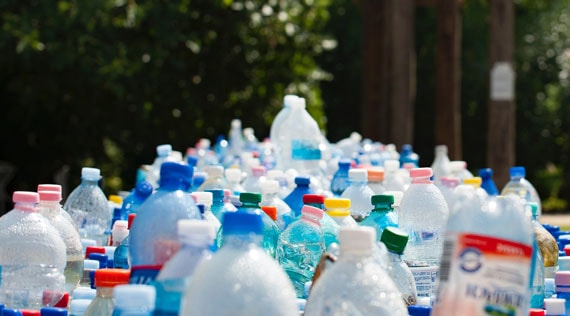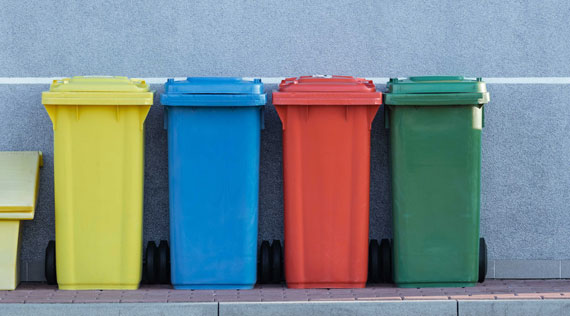The business of recycling has changed — China is no longer buying. And communities in Northeast Ohio and across the country are feeling the economic squeeze. In this installment of our series Reduce, Reuse, Refocus, we took a look at emerging recycling technologies and how they could someday make recycling more economically viable.
You know the drill: it's recycling day. That time, sun or snow, bins are rolled out to the curb.
Soon that mix of plastic, glass, jumbled paper and metal cans will be processed, packaged and sold into the commodities market.
But not everything is truly recyclable, like soiled and degraded paper or certain kinds of plastics.
Since China banned the import of much of the world's recycling in 2018, the United States has been caught in what some are calling a "slow moving recycling crisis."
So if this single-stream recycling way of life is failing, what else is out there?
Looking south
In Montgomery, Alabama, which population-wise is almost the same size as Akron, recycling is still as easy as rolling a bin out to the curb. But instead of sorting trash and recycling, residents put all of it into a single container.
"You know it’s sort of unheard of for recycling traditionalists to put recyclables in the same bin as your food waste," said Amanda Miller with Montgomery's Neighborhood Services Department.
It's called mixed waste processing.
Montgomery has partnered with a company called RePower South to process its recycling stream using infrared and artificial intelligence technology to separate recycling from regular household garbage.
"There's a lot of mechanical sorting that occurs. There's pneumatic sorting that we use, basically using air to separate materials based on its density," RePower South CEO Brian Gilhuly said.
But what about contaminated recyclables? Or what China is no longer buying?
Gilhuly said RePower South can break that material down into very small pieces and make it into an engineered fuel that's meant to be a coal alternative, dubbed ReEF fuel, that's sold to energy utilities and industrial companies.
He touts it as a cleaner-burning, more sustainable fuel solution.
"We could never replace 100% of the coal consumption, but we are reducing the amount of coal that is being consumed. We're taking another bite out of it, which is a good thing."
Is mixed waste processing the future?
Anne Johnson with the consulting firm Resource Recycling Systems has her doubts. She said people have spent decades separating recycling from trash for a reason.
"That is really important because you are keeping things like wet food, dirty diapers, bags of cat litter out of your recyclables," Johnson said.
RePower South touts its advanced sorting tech, but Johnson thinks the risk of contamination is too high.
"You are inherently degrading that material. There is no magic wand you can wave over it."
Johnson points to another emerging technology that can recycle what's long been seen as unrecyclable or too contaminated to be worth anything. It's called gasification, a process that breaks down waste to the molecular level.
Could gasification be the answer?
Gasification isn't new, the technology has been around for decades. But what is new is using the process to turn waste into renewable energy and help augment recycling streams.
In California, the private waste-to-energy company Sierra Energy has partnered with the Defense Department to build and test a gasification plant at Ft. Hunter Liggett.
"So essentially, it’s chemical recycling," Sierra Energy's Meredith Roberts said. The company uses the technology to turn "really any type of waste into a renewable product without burning. And with no toxic byproducts."
From household garbage to hard-to-recycle plastic to old tires and even railroad ties, gasification uses heat, steam and oxygen to break down waste. That chemical reaction produces what’s called syngas, which can then be converted into a slew of renewable energy products.
Roberts is excited about its potential to work side-by-side with existing recycling technologies.
"Gasification is emerging. It’s becoming more and more viable. We hope to sort of line up with those existing technologies so that we can be a real option."
What's next?
Sierra's plant is still relatively small and still in the data gathering phase, but a little more than 1,600 miles North in Edmonton, Alberta, large-scale gasification is already at work.
So when will we see gasification take off around the country or even in Northeast Ohio? We'll have to wait and see, Johnson thinks.
"Certain communities I think will adopt it," she said, but widespread implementation would take a drastic shift in policy.
Right now fossil fuels are cheap. And in many places landfill space is abundant. So why embrace technologies that lessen dependence on landfills and produce renewable energy products?
Johnson said the country would need to move away from its existing recycling way of life to embrace waste-to-fuel processes.
"You know the business model will be challenging if we don't have policy that says it’s important to look at alternatives."
But who knows what will happen in five, 10 or 20 years, when we'll likely still be rolling our recycling bins out to the curb?
What happens to our recycling next could be completely different.
Courtesy : www.wksu.org

